Phone Safe
Freddie & Almon
Rodolfo Cossovich
Context and significance:
My previous Group Project is an artifact that controls and adjusts individual’s mind, especially when the situation is difficult for the individual to decide whether to adapt an emotional way of thinking or a logical one. The artifact force the individual to act in on particular way or in both halves. Hence it is changing people’s mind consistently through outside force. When it comes to the logical part, since we modern people are addicted to our mobile phones so much, The way to stop this and help us concentrate on other things is to either change the thinking method into a logical mode, or, use a phone safe to completely cut the physical connection between the procrastinator and the mobile phone.
I got the idea of the phone safe by reflecting on the two previous app: Forest and Pomodoro, that I’ve used on my mobile phone to help me concentrate when I’m studying or resting. The main function of these two apps is to set time of concentration by the user and then the app will help lock all the other apps and the phone itself when the timer is on and the person should focus, after the timer is out, it gives rewards by a 10-minute and successfully planting a beautiful virtual tree respectively, but if the user do break the timer and play one’s phone, the reward will be gone, the user have to focus longer or lose a beautiful tree respectively.
But there comes a problem: that the user can actually not focusing often by merely closing it and starting playing phones again, which is totally not effective particularly for those who lack good self-discipline. These apps are non-mandatory so it is completely up to the user him/herself. So I considered whether the idea exist that can directly and thoroughly cut the connection between user and the mobile phone. That is where I came up with the idea of a safe that kept one’s phone inside for a period of time. This safe can be opened by completing concentration on study, namely, by opening a moving door that opens after the timer runs out. The safe contains a little shelf for the phone to lie on and can be easy to take out and put in, and a wireless charger for iPhone users (not supporting Android users currently) to charge their phone during the time of their concentration without taking out their wire charger on purpose. The door of the safe will close automatically after the user set the time and press start and after the time of concentration. Between the time of concentration, a small sun will come out and represent the time to focus on your current work/rest.
The exciting thing about this artifact is that it directly uses physical isolation instead of virtual isolation, which enhance the interaction between the user and the artifact itself. My project especially aims at people who can’t get rid of the addiction of their phone (including me). I think this to some extent help those people with getting rid of procrastination and building self-discipline.
Conception and Design:
1. I designed a slope structure as the inner structure of the phone safe. Instead of lying down or leaning on the wall, the phone can be placed safely and in the same time easy to take out, which makes the process of this interacting more smoothly. My safe structure were all made by firm cardboard. It will be better if I use wooden structure or iron structure but I can’t get access to these materials or they’re too hard to cut and adjust to the shape that I want.
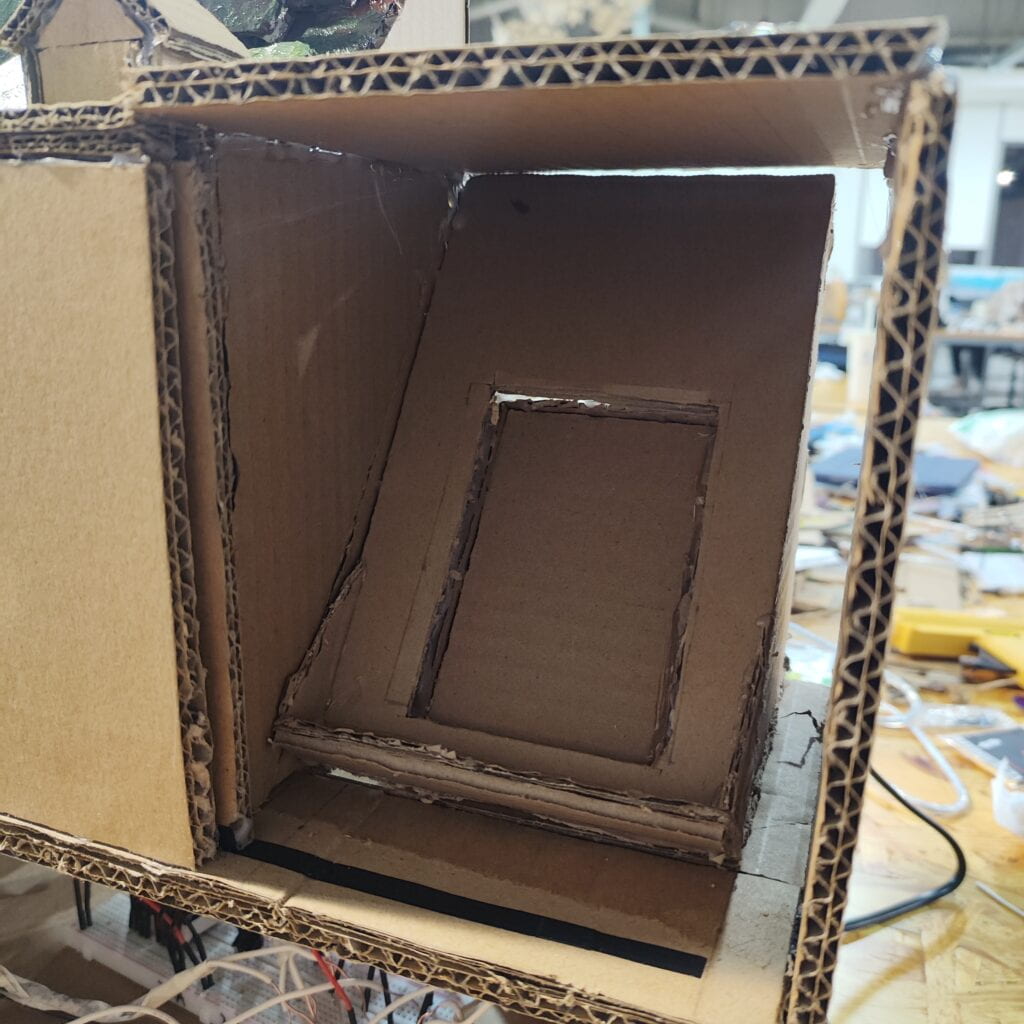
2. I designed scene of a three dimensional picture with mountains, forests, grasslands, a river and a small house. I also designed a sun with a servo and a slider-crank mechanism giving power to it that moves it up and down. I wanted to make a scene that reminds people of the concentrating time period and what should represent it. I first came up with the idea of the sun and the moon representing working and resting. But that was too much workload so I just built the moving sun representing working time. I use cardboard to create the scenery because cardboards are easy to be shaped even in irregular shapes. I use firm cardboard sticks and a metal stick to build the slider-crank mechanism. I only use one metal stick because metal are usually very heavy to move by a servo that produces small amount of power. By using more firm cardboard stick, I can easily make the mechanism work.
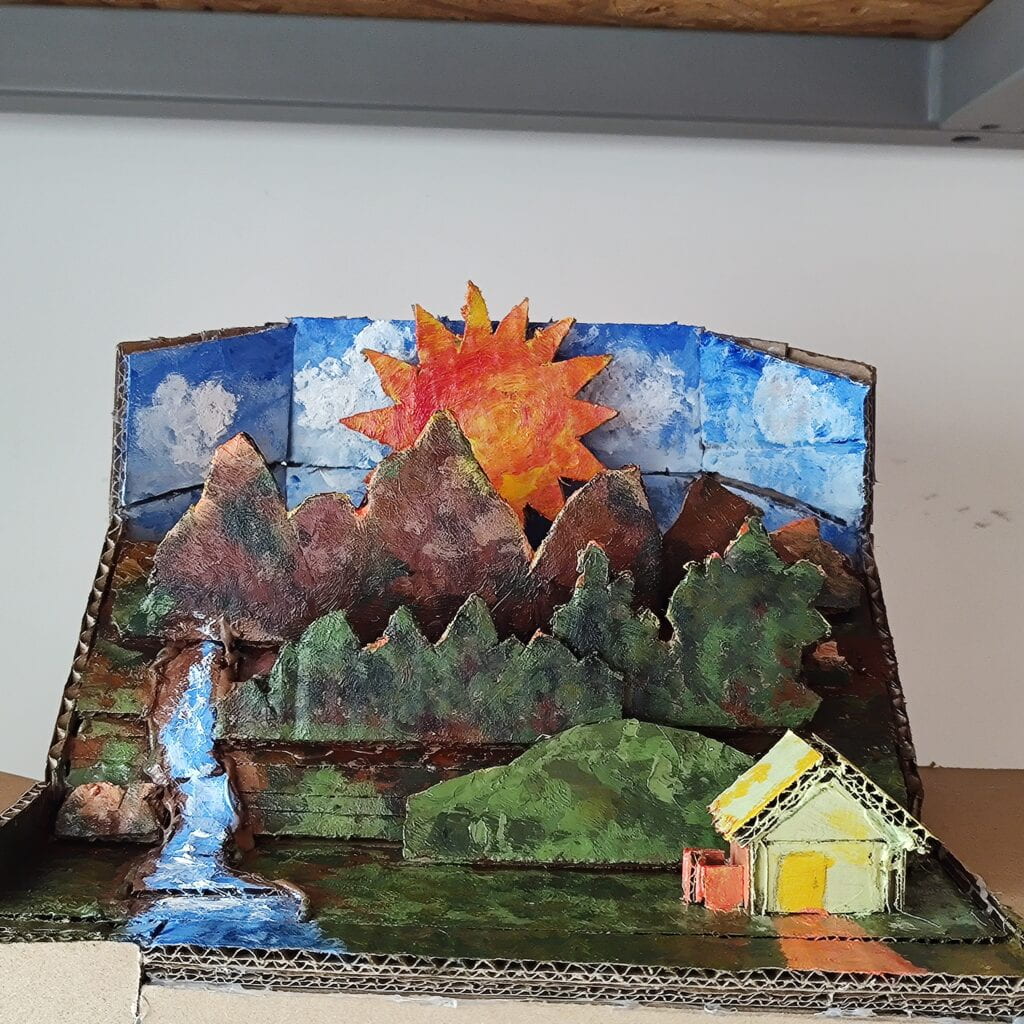
3. I designed a door that moved in horizontal direction which represent the opening and closure of the phone safe. The door is using the same structure but with a more powerful servo giving power to the door. The moving door is secured by a semi-sealed track that limits the door only to move in a linear route. Also, the track structure has a secured door that covers the mechanism inside the moving door. The structure of the door is all made of firm cardboard. I think of using the wooden door but that may create more friction that makes the door harder to be moved.
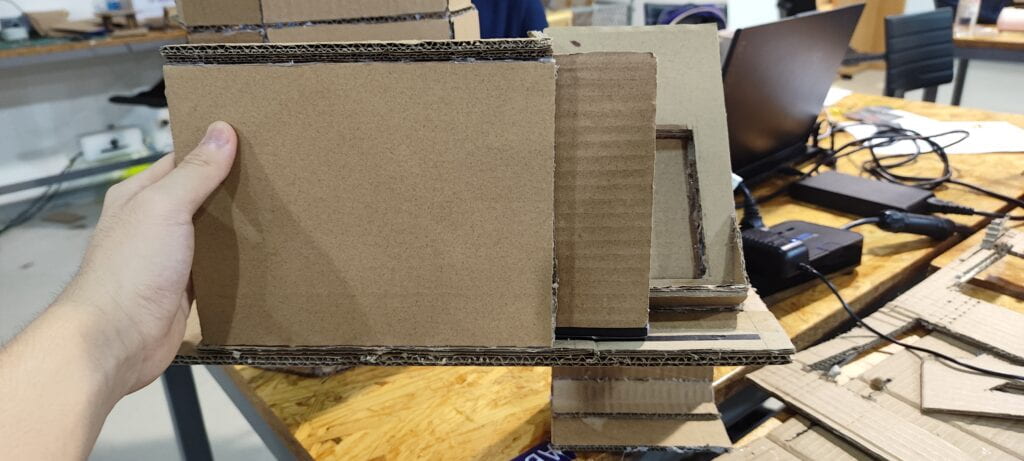
4. The mechanism of the timer with connects to the two servo and slider-mechanism is designed by Almon. The main structure is a box with three buttons in an isolated box which only connects three circuit lines with the main circuit. The green button is used to control the start and end of a period of set time. The yellow button is used to set the exact number of every digit. The red button is used to select different digit and forward the set number. After the timer is on, the door of the safe will close automatically, following the rising sun. When the timer is out, the door will automatically open, following the falling sun as well.
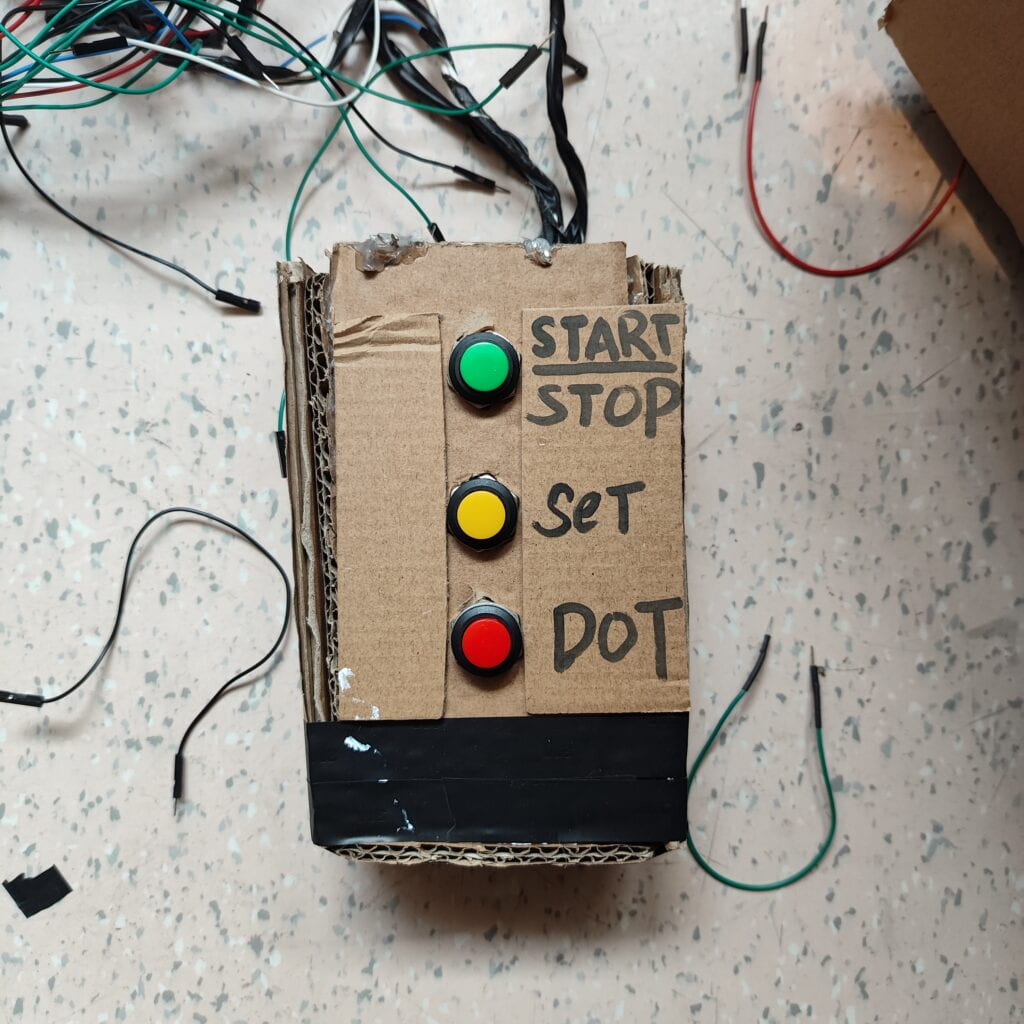
Fabrication and Production:
I am not good at coding so I am in charge of all the arts, mechanism and cardboard structure. The first significant step is the slider-crank mechanism that makes the sun moves up and down. We were poorly organized and lacked time before the user testing so we only made one structure and draw an initial painting of the scenery. The slider-crank mechanism is relatively easy. I followed the same structure of the mechanism in the Recitation 4 and modify it so that it can move more distance. Also, I replaced the plastic circle with a metal stick that does the exact same thing, but with less weight and less space being occupied.
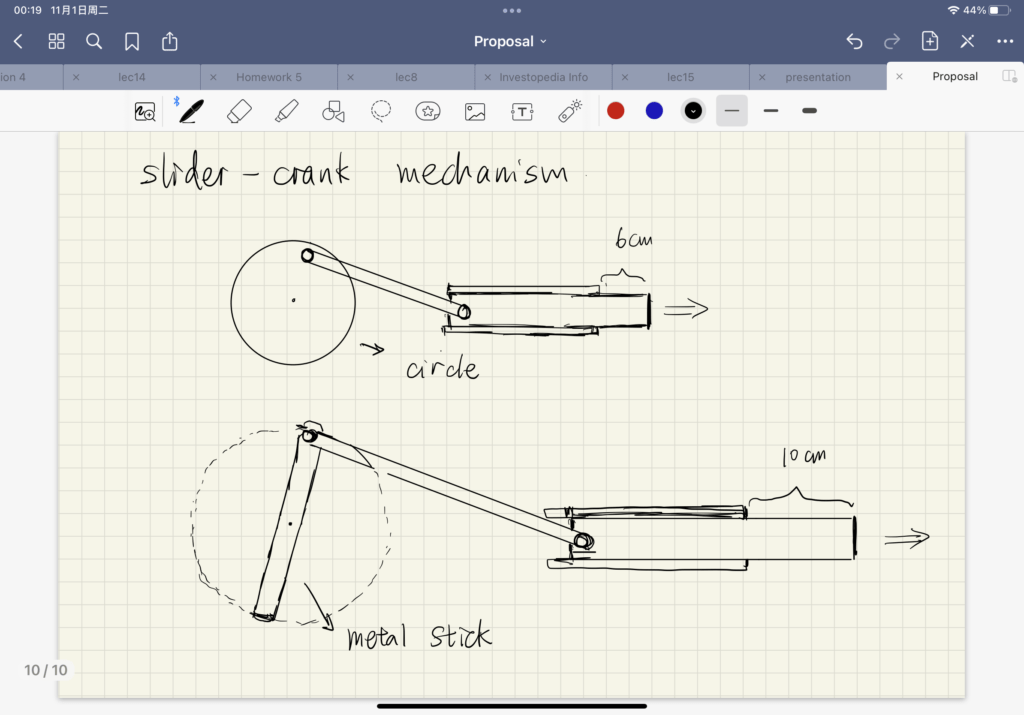
Almon and me originally thought of using a light sensor to move the slider-crank mechanism. I connected the light sensor with the servo and Almon did the coding that connect the two function together. Basically the user use a light sensor to imitate the natural sunlight that comes out every morning. When the light sensor sensed a greater number representing the intensity of the light, it would trigger the slider-crank mechanism to move and thus the sun came out. The project is initially an alarm that wakes the person up in the morning according to the rise time of the sun every morning. Since the time of the sunrise differs throughout the year, the alarm can naturally change the person’s biological clock and make a closer contact to the natural mechanism.
I built a platform that could contain the scenery inside. I used several triangle shape to make a more beautiful three dimensional scenery background. I make a slope that indicates the height of mountains and forests. I cut the shape of mountains and forests in two dimensional figures and used glue guns to stick it on the slope to make the scenery with more layers, which made it look more vivid from the front direction. I then used painting brush and pigments to paint the mountain, forests, grassland and the river.
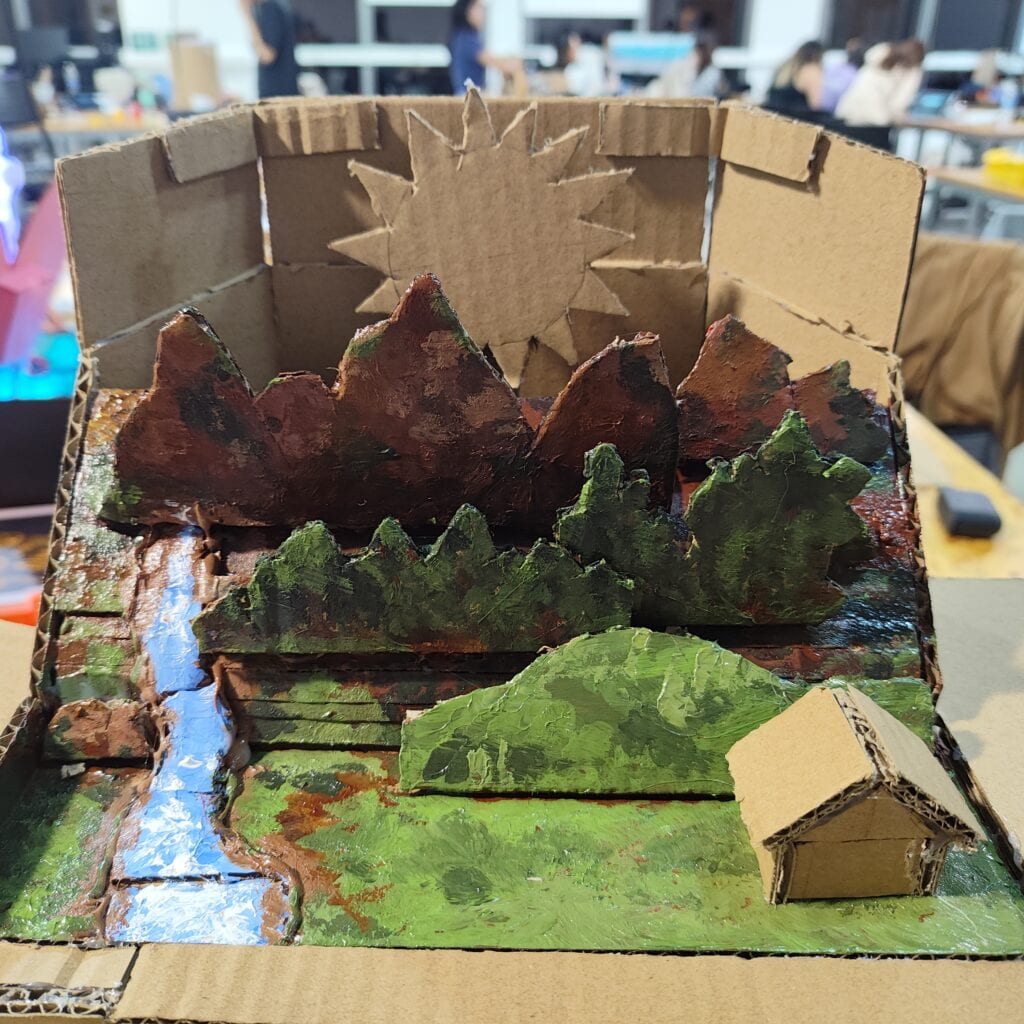
The user testing came and we didn’t get prepared of our project at all, I simply cut a hole on one side of the box under the scenery and stuck all the mechanism, Arduino and the circuit inside the box. We first named our project Sunlight Alarm.
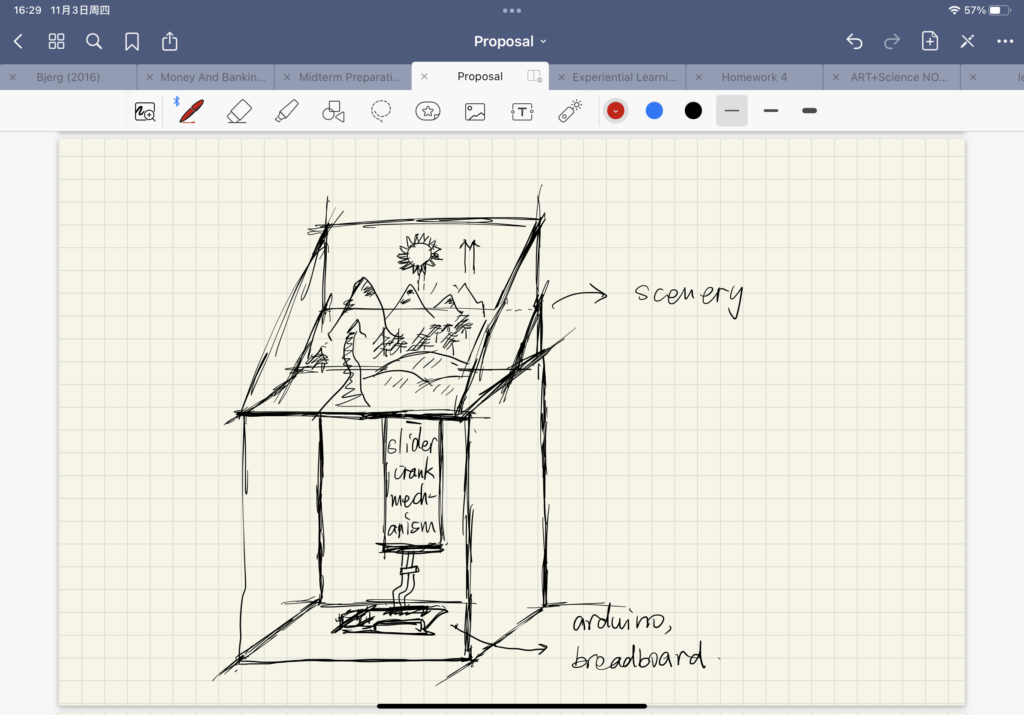
During the user test, the project seemed to function really well. However, there are two main problems: The one is that the users cannot try to understand how the whole mechanism works without our simple instructions like “click the button here” or ” use it to illuminate here”. That indicates our project lacked interaction. The other is that with extremely simple principle and mechanism, the definition and orientation of our project is vague. It can’t be used as a useful alarm clock or be an interactive art composition.
Our user testing is awful so I found our professor Rudi the moment user testing section ended. Rudi helped me with reconsidering the orientation of our project and even reversed our project. He helped me listed the ideas and thoughts of how the artifact should focus on. It could be something useful, something artistic, or something people can reflect on in the daily life. He then guided me to do brainstorming. That was when I came up with the idea of making a phone safe. And it is something that people can reflect on. Rudi especially advised me to focus on one particular function or orientation and never mix things up.
Regardless of the change of the idea and direction, I still retained the scenery and the moving sun for several reasons: To begin with, I thought that the scenery wasn’t a contradicting part against other useful parts. I simply kept this because I love the painting and I enjoy appreciating it every time I happened to take a glance at it. What’s more, I thought of the connection between the rising and falling of the sun and the reminder of concentrating and rest: The sun rises, the day starts and people start producing, the sun falls, people rest. So it made more sense to use the sun to indicate a period of time of concentration. I even thought of making a sun that turns certain angle at certain speed based on how long the user sets the concentration time, because it enhanced the process of interaction. But we failed to realize that because it is too difficult for us.
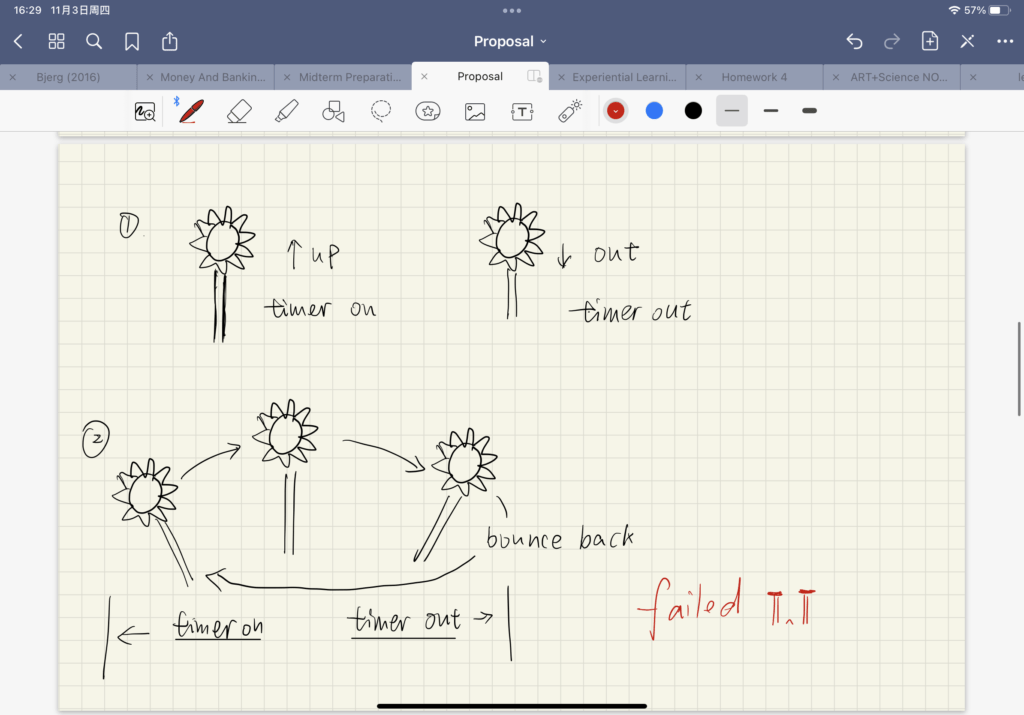
The most difficult part of the project was to build the automatic moving door. I primarily separated my work into three parts.
The first phase of the work is to built a structure similar to the slider-crank mechanism. I planned to organize the position of this mechanism in this way.
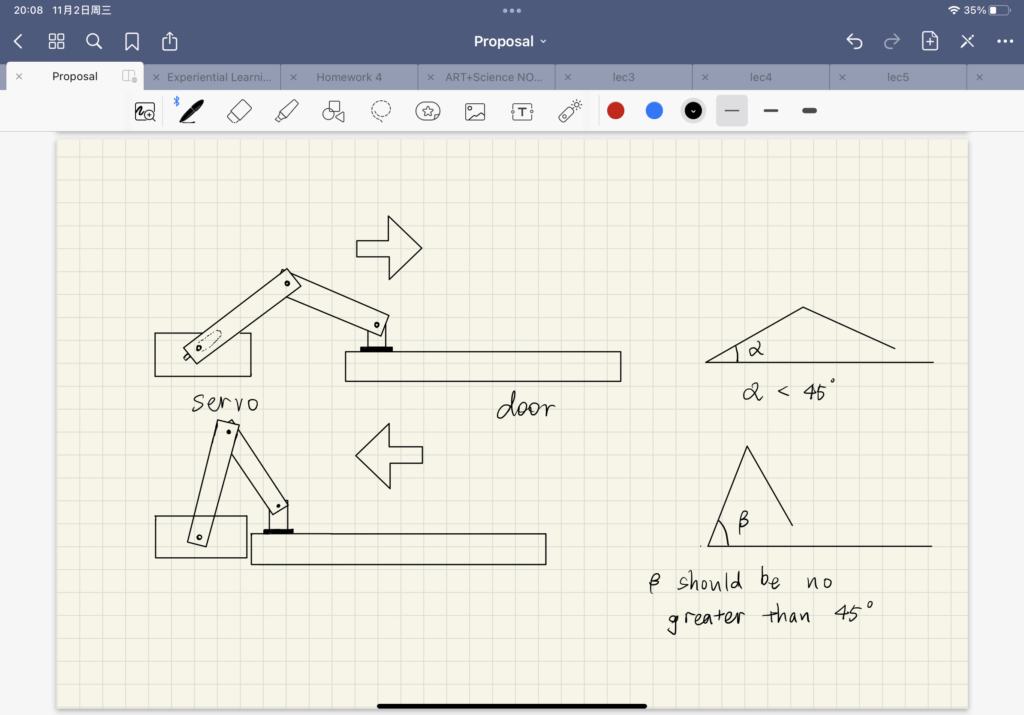
It seemed to have some problem to move. Because the angle between the door and the driving stick can’t be greater than 45 degree, otherwise it can’t be moved regardless of how much power you use on the gears in the servo motor. Since I wanted the door to be moved 12 centimeters back and forth, the distance is too much for a single slider-crank mechanism to move because it required turning too many angles.
Then I changed my idea a bit, which was the work mainly done in the second phase. I modified a single slider-crank into three slider-cranks that were bound together and can move longer distance without turning too many angles.
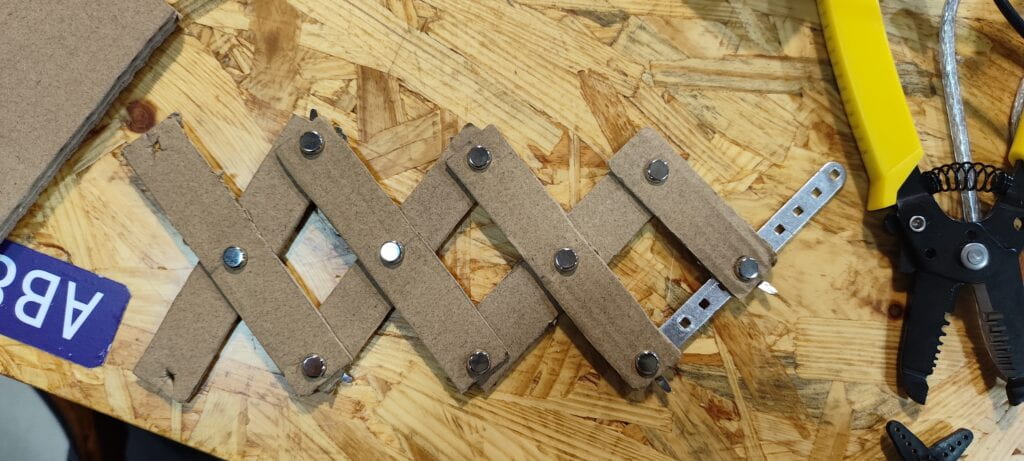
Although I spent much time measuring and producing those branch sticks, this modified mechanism cannot move the door at all. Every time it starts to turn, the sticks are stuck behind one side of the door. The sticks made by cardboard seemed to be too weak to transmit force and they were not able to stretch before they could move the door.
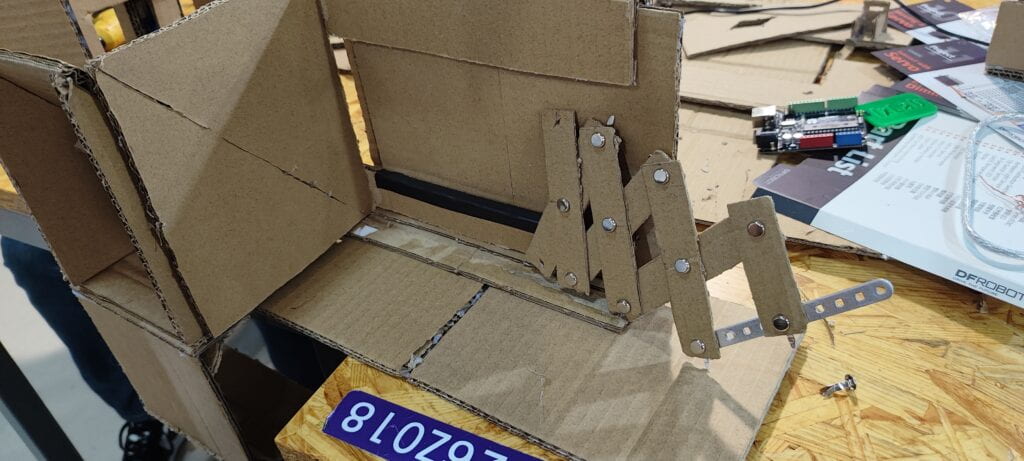
As a result, though I kind of wasted huge amount of time on working something that didn’t help our project at all, I did learn something from this experience. The practical lesson I’ve learned from this complex mechanism is that the mechanism itself have to be concrete. I can’t use a light mechanism to move an object that is much heavier than it. Also, the artifact made by cardboard isn’t strong enough on a two dimension level. If an artifact made by cardboard has to be firm, it has to be built on a three dimension level. That is why the slider-crank structure can’t transmit force easily. The general lesson I’ve learned from this failure is that don’t rush to try something you fell uncertain and unconfident about it, especially when the time is limited and you have something else essential and important to work on too.
Finally it came the third phase. Due to a lack of time, I went back and reconsider the slider-crank mechanism and I thought maybe it can work if I make the whole mechanism stand and simply make all the sticks longer. By following mg thoughts, fortunately, I managed to make the door move. I adjusted how many angles the slider-crank should turn and it worked.
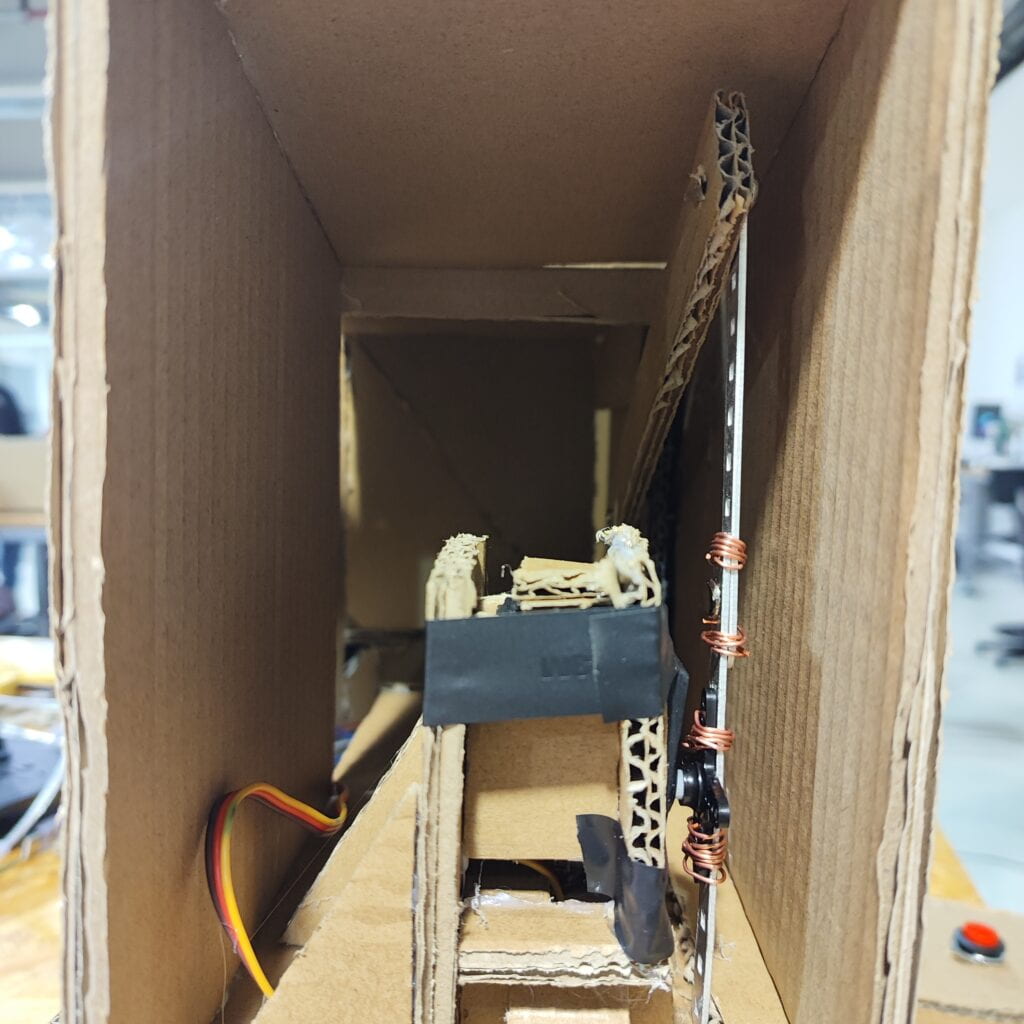
Another modification I’ve made is to further simplify the slider-crank mechanism. Because of the great length and space the mechanism in the third phase might take, it required too may cardboards and more space that couldn’t be fully exploited. So I made the following adjustment:
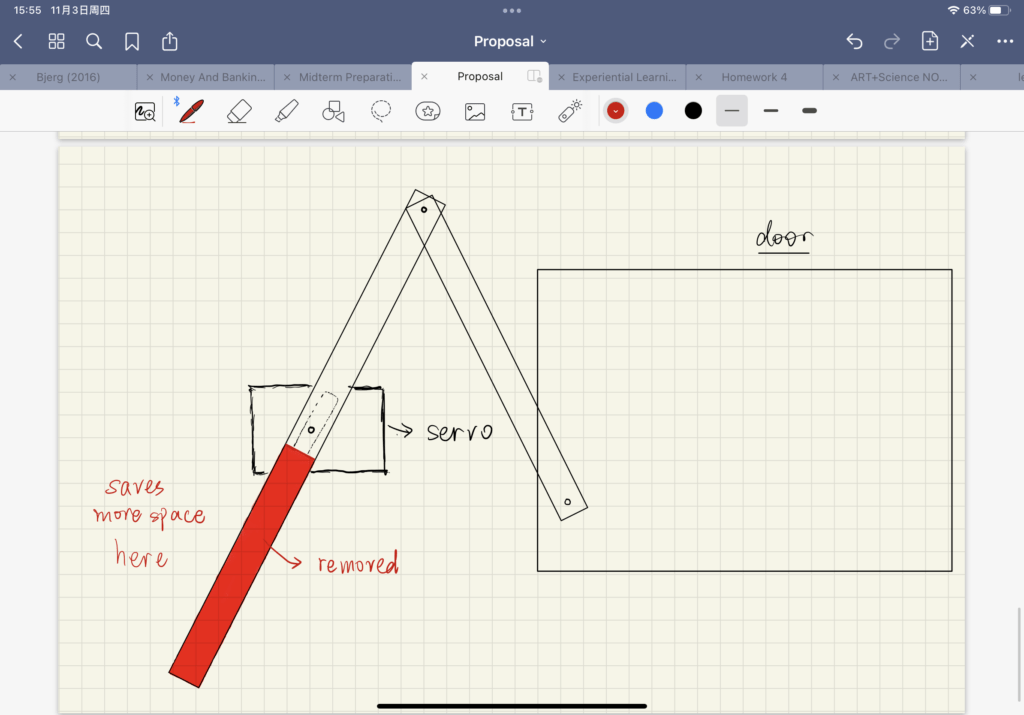
After I’ve finished all the mechanism , I made a cover of cardboard to combine and cover all the mechanism structure and Arduino circuits.I made several signs to guide users to use our artifact. For the coding structure and the circuit, Almon completed almost all of them.
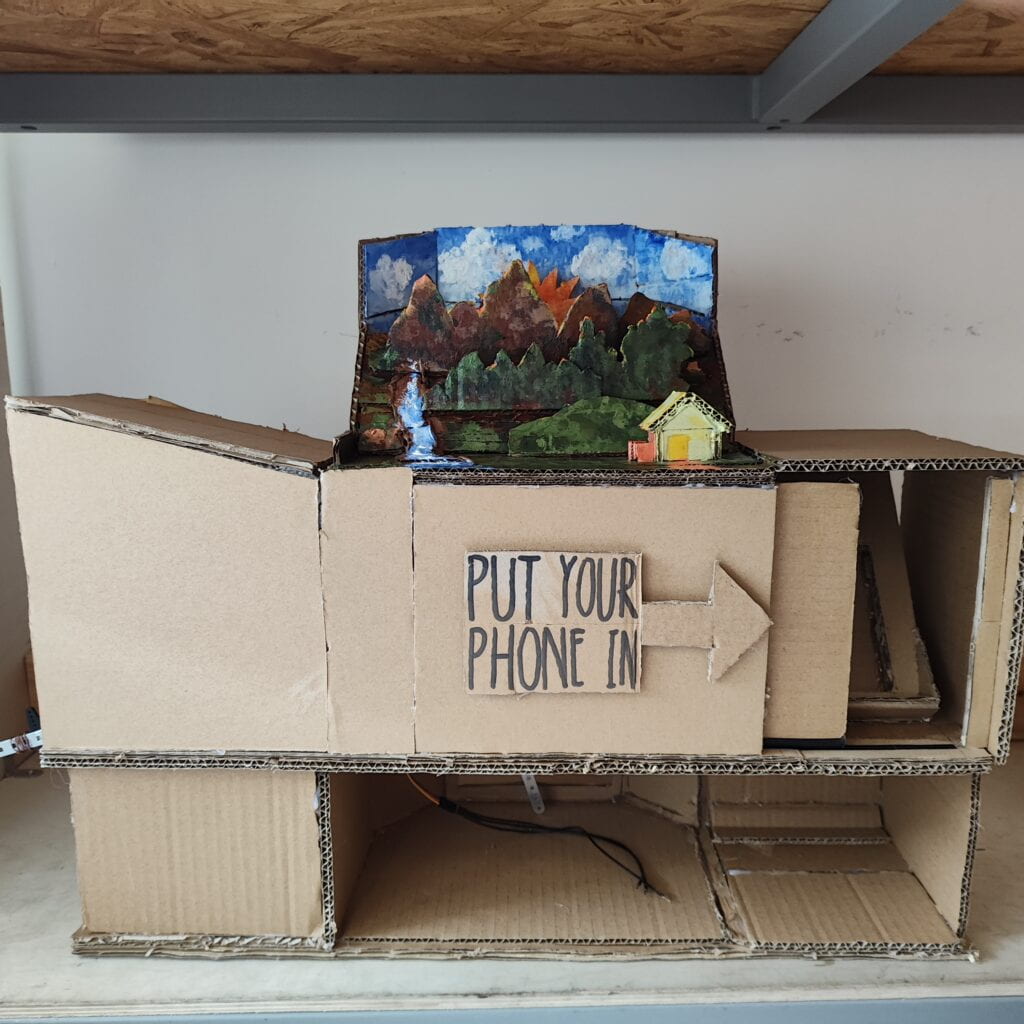
Conclusions:
The function of physical isolation of one’s phone is something that I considered as an interaction. It prevent potential but unnecessary desire to use the phone that has already existed in apps help one to concentrate. The main problem that this artifact was not aligned with the definition of Interaction is that it lacks a reward-punishment mechanism where the artifact subjectively interacts with the user. The main drawback during the presentation is that the door wouldn’t open automatically, which can be fixed by adjustments on the coding. Also, the appearance is a bit messy because people can still see the circuits. I think the biggest lesson I’ve learned from this project is to always make practical plans and never stop believing yourself.
The sun also rises.
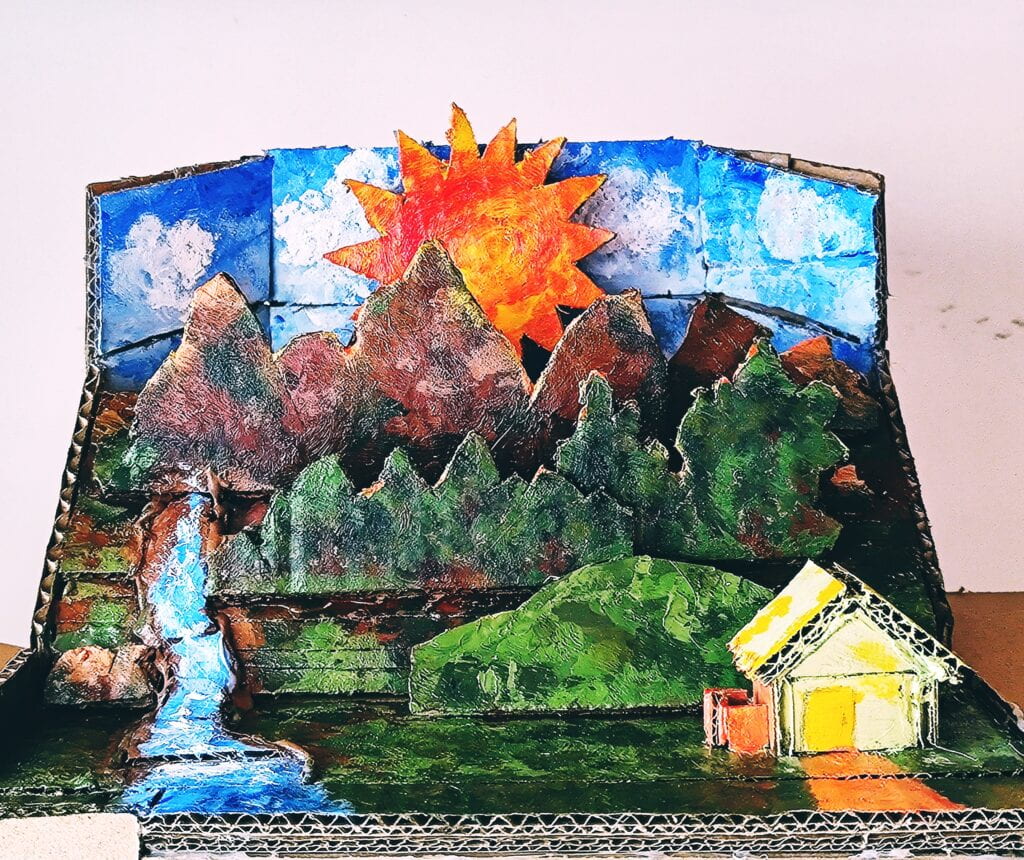
Annex:
Here is the code we’ve used:
/* Arduino two digit 7 Segment Display Counterdown Timer
